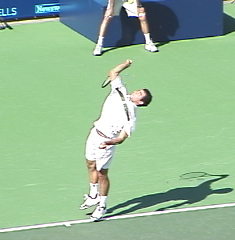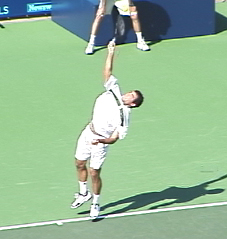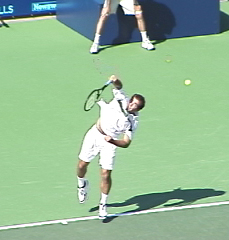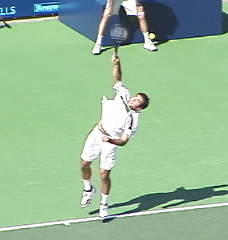<% ns_puts [mkm_getnavbar] %>

Advanced Tennis: Sampras Serve
High Speed and Heavy Spin
John Yandell
Recently, an article in a major national tennis magazine made a startling claim. Pete Sampras hits his serve completely wrong. Written by a teaching pro (and self-proclaimed former TV actor), the article claimed Pete’s serving effectiveness was a matter of natural ability and/or luck triumphing over terrible bio-mechanical technique.
John McEnroe had a different opinion. After Pete’s dramatic 5th match Davis Cup triumph versus the Czech Republic, he described Pete’s serve as “the greatest of all time,” and “a serve I dream about having.”
Was “Tom the Tiger” (as the magazine writer described himself) right in warning players NOT to imitate Pete? Or was his article a tremendous waste of scarce national media ink? Can the average player learn really something from the greatest server of all time?
Advanced Tennis Research Project
For the last four years, the Advanced Tennis Research Project has been studying the physics and bio-mechanics of pro tennis, including the serves of many top players, including Pete Sampras. In this exclusive
|
What makes Pete Sampras the greatest server in tennis history? |
Pete’s serve is one of the most effective serves -
if not the most effective serve - in tennis history. And the research we
have done at the Advanced Tennis Research Project is beginning to explain
why. We believe that Pete’s motion provides an ideal model for
developing both fundamental and advanced technical elements, regardless
of any nonsense or polemics you may hear elsewhere.
Subsequently articles will analyze the bio-mechanical elements that go into this unique motion, and discuss what players at all levels can learn from Pete to dramatically improve their own serving.
The Speed/Spin Ratio
So what sets Pete apart from the other players?
Pete Sampras’s serve - the quality of the ball he produces - is
physically, quantitatively different from other top players. How?
Sampras is far from the fastest server in pro tennis. He averages 120-125
mph on his first serve, but so do many others on the ATP circuit. What
makes his serve unique is his use of spin. Or more precisely, his
combination of speed and spin, what we call the speed/spin ratio. The ball
that Pete produces on both his first and second serve is unique in the
relative amounts of speed and spin. His serve combines a unique amount of
speed with a unique amount of spin—a combination no other player is
producing.
We believe that this speed/spin ratio explains
Sampras’s uncanny ability to serve so consistently over time and to
produce huge first and even huge second serves at key times in tight
matches.
For the last 3 years, the Advanced Tennis Research
Project has been filming the world’s best players in high speed digital
video. This has allowed us to complete the first study of the levels of
ball spin in pro tennis. The results have been fascinating.
The Sampras Advantage
On the average, a Pete Sampras serve traveling at
120mph is spinning at around 2700 rpm. To understand the amount of force
this spin generates, start your car, put it in neutral and rev the
tachometer to 2700rpm. That’s a lot of force. It’ll propel your car
down the highway at 65mph.
 |
 |
|
|
 |
Heavy spin combined with high velocity--his unique speed/spin ration--separates Pete Sampras's ball from other players and helps explain his phenomenal serving consistency and effectiveness. |
|
Put another way, it takes ¾’s of a second or less for Pete’s first serve to reach the opponent’s racket. In that split second, the ball has made 35 or more complete revolutions! Try visualizing the ball turning over 35 or 40 times between the serve and the return the next time you watch Pete play on TV or better yet in person. It happens faster than the human eye can see.
This level of spin combined with speed is what sets Pete apart. Compared to some other players who hit with similar velocity, Pete can generate up to twice as much spin on his first serve, or even more. For example, when we measured players such as Andre Agassi and Michael Chang, we found that although their first serves did on occasion reach 120mph, typically these serves were spinning at 1000 rpm or less.
First Serve Spin Rates
| Player |
AV MPH |
RPM Range |
Av RPM |
|
Marcelo Rios |
92mph |
3000-3333rpm |
3167rpm |
|
Todd Martin |
98mph |
1667-3947rpm |
2798rpm |
|
Pete Sampras |
120mph |
2100-4260rpm |
2699rpm |
|
Andre Agassi |
102mph |
1200-4284rpm |
2449rpm |
|
M.Philippoussis |
123mph |
1765-2830rpm |
2198rpm |
|
Michael Chang |
112mph |
1000-3750rpm |
1677rpm |
|
Tim Henman |
120mph |
1429-1667rpm |
1548rpm |
Tim Henman, one of the few great serve and volley
players on the tour, matched Pete’s average velocity at 120 mph, but the
level of spin on his ball was around 1500 rpm, only slightly more than
half of Pete’s.
The only player who approached Pete’s spin/speed ratio was Mark Philippoussis. We measured Philippoussis’s average speed at 123 mph, about the same as Pete’s. His average spin rate was about 2200 rpm, which gave him easily the second highest ratio of spin to velocity. But he was still hitting 15% less spin than Sampras.
It is important to note that Pete is not hitting the
most spin on the first serve of all tour players. Again, it’s the ratio
of speed and spin that makes Pete unique. We found several players who
were matching or exceeding Pete’s spin level of the first serve, but
their serves had far less velocity.
Todd Martin for example averaged almost exactly the
same amount of spin as Pete, about 2800 rpm, (compared to Pete’s 2700
rpm). But Todd’s serves, at this spin rate, averaged only 98 mph.
Marcelo Rios actually averaged more spin on his first serve than Pete at
about 3200 rpm, but his velocity was 92 mph, almost 30 mph slower than
Pete!
Over the years Pete has been at the very top of the game in terms percentage of first serve points won. Our spin study sheds a new light on why. It also has important implications for the future of coaching and teaching. Clearly for young players, developing great velocity is only half of the story. A great server has the ability to combine great speed with great spin.
Second Serve Spin Rates
|
Player |
Av MPH |
RPM Range |
Av RPM |
|
Andre Agassi |
74mph |
4054-4998rpm |
4650rpm |
|
Tim Henman |
85mph |
4284-4998rpm |
4641rpm |
|
Pete Sampras |
85mph |
3900-5357rpm |
4623rpm |
|
M.Philippoussis |
99mph |
2830-4546rpm |
4018rpm |
When it comes to the second serve, our study was
equally revealing. Sampras is generally considered to have the best second
serve in pro tennis. The study of the speed/spin of his second serve
provides a good indication why.
Pete’s second serves we filmed averaged 85mph. They
were also spinning at the amazing rate of over 4600 rpm. Pete hit the
single fastest spinning ball we recorded - a second serve traveling at
over 5300 rpm. Try that on your car tachometer, but be careful not to over
rev your engine! This is simply a phenomenal amount of spin. In the time
it takes for Pete’s second serve to reach the returner, his ball can
make 60-70 revolutions. That’s even more difficult to visualize than the
first serve.
Again the comparison with other players is
instructive. Andre Agassi generated about the same average spin as Pete on
his second serve, 4600 rpm, but averaged only 74 mph, 10 miles an hour
less than Pete. Todd Martin’s second serve velocity was actually a
little faster than Pete’s at 89 mph, but at about 3400 rpm, he was
hitting only 3/4’s as much spin. Only Tim Henman’s speed/ratio on his
second serve appeared to be similar to Pete’s. Philippoussis on the
other hand was averaging about 100 mph, and about 4000 rpm.
The full implications of the discovery of the
differences in speed/spin ratios are still under study by our research
project. Potentially, they provide an entirely new, quantitative method
for evaluating pro players, and aspiring pro players, not only on the
serve, but on every other stroke as well. (For more information on the
Advanced Tennis Research Project and the levels of spin for all strokes,
go to www.AdvancedTennis.com).
But some things are already clear. It’s obvious
that to generate these combinations of speed and spin, Sampras is also
generating more racket head speed than other top pros. The question is
how? Undoubtedly, this is due in part to his incredible natural ability. But
our high speed digital filming of his motion and bio-mechanics indicates
that this racket head speed is also due to a special combination of
technical factors, factors that allow him to maximize his full potential.

To view the complete ProStrokes Gallery of digitally mastered Pete Sampras serves, click here.
Your comments are welcome. Let us know what you about think John Yandell's article by emailing us here at TennisONE.
Last Updated 6/1/00. To contact us, please email to: webmaster@tennisone.com
TennisONE is a registered trademark of TennisONE and SportsWeb ONE; Copyright 1995. All rights reserved.


